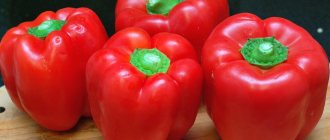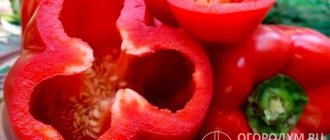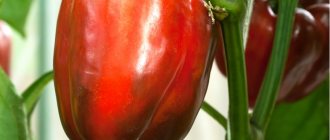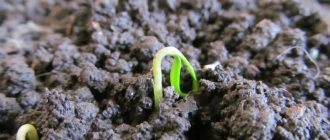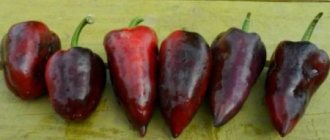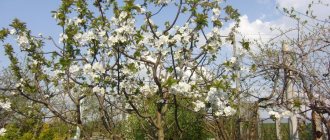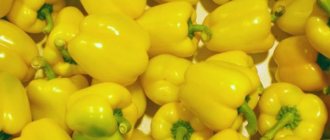Characteristics of decorative pepper
Decorative peppers have come into fashion recently, but they are quite an ancient culture. It was possible to see pots of pepper on the windowsill many decades ago, but in recent years many varieties have appeared, specially bred for home cultivation. This vegetable belongs to the nightshade family, is found wild in Asia and America, and is grown everywhere in apartments. It is a perennial ornamental plant; its bushes, as a rule, do not exceed 30–40 cm in height.
In reality, the lifespan of a plant in an apartment is about five years, but many people grow it as an annual, without leaving it for the winter. If pepper leaves, which have an oblong, lanceolate or ovoid shape, do not differ much depending on the variety, then the appearance (shape and color) of the fruits can be very diverse. The size, as a rule, does not exceed a few centimeters. A bush planted at home performs a decorative function both during flowering and during fruiting. One plant is enough, since the crop is self-pollinating.
As a rule, this pepper blooms in early summer, and the fruits ripen from August to October. Home-grown varieties are pungent and contain the alkaloid capsaicin. It is the fruits that are used in small quantities in cooking; vegetative parts of the plant are poisonous.
Varieties of decorative peppers
There are dozens of varieties of decorative peppers, and most of them are edible. Of course, these are the ones that are planted mainly by indoor gardening enthusiasts. The most popular varieties are the following.
- A small miracle - a plant up to 30 cm high, lush, with red fruits sticking out upward, weighing up to 5 g. Medium-sharp, used fresh and in cooking.
- Jellyfish is a bush no higher than 25 cm, heavily leafy. The fruits are thin, elongated, up to 6 cm long, red, spicy. It is highly unpretentious.
- Ogonyok is perhaps the most famous variety with fairly large (up to 40 g) bright red, burning fruits. Universal use.
- Aladdin is a variety grown in open ground, where it grows as a half-meter bush, on the windowsill - a little lower. The fruits have a transitional color: during the ripening process they are yellow, purple, and red. The taste is very spicy.
- Phoenix is a variety that grows as a low but spreading bush. It bears fruit on the windowsill for a very long time; cone-shaped peppers up to 4 cm long are directed upwards. The color ranges from yellow to red, the taste is moderately spicy.
- Salute is one of the easiest varieties to grow, bushes no higher than 25 cm. Peppers weighing up to 6 g, orange, with a fiery taste.
- Filius Blue is a pepper that bears purple fruits, but their color during ripening can be orange or red. It can bear fruit almost all year round. The bush is no more than 25 cm high, but spreading, requiring free space. The variety is high-yielding, the purpose of the fruit is universal.
- Indian Summer is a rather old variety, shade-tolerant, grows as a low, rounded bush. The fruits are round and weigh about 5 g, the color is dark red, the taste is sharp. The purpose of the fruit is universal.
- Sirius is a Dutch variety, a bush up to 20 cm high, bearing a large number of small fruits that change color from blue to dark red. Considered a novelty, it can bear fruit in an apartment for up to seven years.
Preparatory work
When growing hot peppers at home, it is important to choose the soil, container and seed preparation wisely.
How to get planting material
To grow hot peppers, it is better to choose seeds taken from dried fruits. Alternatively, they can be purchased at specialized retail outlets or in online stores, which offer planting material for ornamental and exotic crops. If you sow it in February-March, you can count on a harvest in September-October. To successfully grow on a windowsill, you should choose the right seed material and carry out its pre-sowing preparation.
Description and characteristics
This is a spicy ornamental pepper variety bred in the Netherlands. It is characterized by small, 2–3 cm, bright, upward-pointing, blunt-conical fruits weighing from 4 to 5 g. There can be up to 50 of them on one bush. Peppers are a type of chili pepper. As the fruits ripen, they gradually change color - green, purple, orange and red.
The plant itself is bush-like, compact, grows up to 20–30 cm. It belongs to the edible early ripening peppers with a spicy and pungent taste. The ripened fruits are used in cooking as a seasoning and for canning vegetables. Bushes are widely used for room decoration.
The best varieties for indoor growing
Due to their high taste characteristics and yield indicators, the following varieties are especially popular:
- Ogonyok. This indoor plant is a mid-early crop; harvesting occurs 115-120 days after planting. The bush is distinguished by medium growth vigor and branchiness. The size of the pods is quite large, their weight reaches 45 g. They grow in a rich red color and have a burning taste.
- Aladdin. The ornamental crop is characterized as medium-sized, its height is no more than 50 cm. The variety is in demand because of its ultra-earliness, it bears fruit abundantly and for a long time. Small peppers are distinguished by their cone-shaped shape, pronounced aroma and pungency. As they ripen, their color changes; when they reach technical ripeness, the skin becomes red.
- Black Pearl. The compact plant reaches only 31 cm in height. The flowers are purple, self-pollinating. Black fruits turn red when they reach technical ripeness. Black pearl pepper does not require large containers; flower pots with a volume of 1.5-3 liters will suffice.
- Small miracle. This Dutch variety of hot pepper has won consumer recognition for its abundant fruiting. The productivity is high, even despite the low growth of the bush, height 20-30 cm.
- Dragon. This indoor pepper is famous for its productivity and undemandingness to growing conditions. The early-ripening crop pleases with its hanging red fruits, their length is up to 5 cm. The height of the bush does not exceed 45 cm, there are not so many leaves. The fruits have a sharp taste and are actively used for preparing assorted dishes, marinades, and as a spice.
Black Pearl Drakosha Little Miracle Light Aladdin
Pros and cons of growing
- The undeniable advantages of the Little Miracle include:
- Easy crop care.
- Relatively unpretentious to soil and lighting.
- Good yield.
- Economical use in cooking.
- Healing properties (in the form of alcohol tinctures for treating radiculitis, rheumatism and pain in the lumbar region).
- Bactericidal qualities - destroys some harmful microbes located in the same room.
- Excellent decorative properties.
As a disadvantage, it is necessary to note the danger for small children: the brightness and attractiveness of the fruits can provoke in children the desire to touch or taste them. And a sharp burning sensation in the mouth is not the worst thing that can happen to a baby. Much worse are burns and irritations from the sap of the plant if it gets on the child’s skin; even more dangerous are burns and irritations to the eyes if the child rubs them with his fingers after mashing the pepper.
Planting and growing peppers
Now let's look at how to grow indoor shrub peppers, Little Miracle. This plant can grow well both outdoors and indoors.
Conditions for planting the variety
The most favorable microclimate for planting a Little Miracle will be one in which:
- Daylight hours are at least 18 hours. A lack of light in the future will cause the ovaries to fall off and the bush to stretch.
- Ambient temperature (during the first week) - +32°C. This can be achieved by placing a regular 60 W lamp at a distance of 12–16 cm from the ground.
- Humidity is moderate, 60–70%.
Selection and treatment of seeds for planting
Seeds for planting can be purchased at any specialized store; their range is quite wide. However, before planting, the seeds must be treated, namely, soaked until they swell in a light solution of potassium permanganate.
Optimal planting dates
The best time for sowing pepper seeds is the second half of March - the first half of April, for planting seedlings - the second half of May - the first half of June. This schedule will allow harvesting from the second half of July to mid-September.
Soil requirements
There are no special requirements for the soil. This can be either any nutritious soil or a specially prepared substrate of 5 parts humus, 3 parts leaf soil and 2 parts sand. The main requirement for the soil when planting is that it must be warmed to +21°C.
Landing Features
Planting can be done either by seeds or seedlings. Let's consider the method of planting seeds. This option is more preferable when planting and growing a Little Miracle on a windowsill.
The algorithm of actions is as follows:
- Select a clean two-liter container and treat it with boiling water.
- At the bottom of the container, create a drainage layer of expanded clay (crushed stone or charcoal).
- A substrate of humus, leaf soil and sand is poured on top of the drainage layer.
- Pour boiling water over the soil and leave until it cools.
- In the cooled soil, make holes one to one and a half centimeters deep, into which two or three pre-prepared seeds are placed, sprinkled with substrate and moistened with a spray.
- The container with the planted seeds is covered with a plastic bag (or glass) and placed until germination in a place where the temperature is +21…+24°C.
To avoid the occurrence of fungal diseases, the container must be periodically ventilated by opening the film (glass) covering for a short period. 10 days after planting, when the first shoots appear, the pot should be moved to a sunny windowsill or provided with additional lighting using an LED or fluorescent lamp. And after another 5 days, reduce the temperature to +15°C. When real leaves appear, they are thinned out, leaving only the strongest ones.
Pepper care after planting
Now let’s look at the rules for caring for the Little Miracle after planting. Let's start with hilling.
This procedure is carried out:
- When the plant is in a pot for a long time . The soil in the container sags, becomes very compacted, the roots and stem are exposed, which leads to the roots losing their ability to grow, absorb nutrients and become susceptible to diseases. In addition, bare roots and stems are unattractive aesthetically. Hilling allows you to improve the health of the plant and increase its stability.
- On the eve of transplantation as a preparatory measure . Due to the strengthening of the root mass in the stage of relative calm, the plant adapts more quickly when transplanted into another pot.
Algorithm of actions for hilling:
- The day before the procedure, water the plant with a small amount of water, but so that the soil is moist, but not wet.
- Just before hilling, the top layer of the substrate is thoroughly loosened, being careful not to damage the roots of the plant.
- Then the required amount of prepared soil is poured into the container, making a cone around the stem. The height of the planting is about ¼ of the height of the plant, while the lower leaves should not come into contact with the soil, leaving a distance of 1–2 cm. Upon completion of the procedure, the pepper is watered.
If the pepper is located on a closed balcony, including in winter, hilling is also necessary; it will reduce the rate of cooling of the soil, and thereby mitigate injury to the plant.
In this case, simple humus or sawdust from deciduous trees is used for rolling. Hilling is done closer to the end of autumn, and in the spring - this topped up substrate is removed, then the pepper will begin to grow sooner. Loosening the soil. This agricultural practice improves the soil structure. It allows:
- Provide the soil with air . The plant needs oxygen throughout its life. The above-ground part receives it constantly, but the underground part sometimes experiences hypoxia, or oxygen starvation. The plant becomes sick and withers. Also, with limited access to air, the plant lacks its important component - carbon dioxide, which it needs for photosynthesis.
- Improve soil structure . Constant loosening destroys small soil capillaries through which moisture rises, thereby drying out the lower layers of the soil.
Rules for loosening the soil:
- The top layer is loosened after watering the next day.
- The depth of loosening is no more than one and a half centimeters.
- It is done carefully, mainly near the walls of the container, so as not to injure the roots of the pepper.
Watering and fertilizing
The first fertilizer is applied as soon as two true leaves appear. Subsequent mineral and complex fertilizing is done every 2–4 weeks. Watering is done with water at room temperature as the soil dries.
During the formation of ovaries, the frequency of watering increases. In addition, the plant is extremely useful when sprayed with a spray bottle - once a week.
Trimming
Pruning, or more precisely, pinching the crown, is done when the pepper grows to 20 cm. The purpose of pinching is to improve the branching of the bush, increase productivity and improve decorative qualities. It makes the bush compact, stimulates abundant flowering and strengthens axillary buds. Removal of the crown is done with scissors or a knife.
Transfer
Held annually. The plant is transplanted into a larger pot using the transshipment method. The essence of the method is that replanting is done while preserving the earthen clod on the roots of the plant. The method is preferable in that it can be used at any period of growth of an adult plant without harm to it.
The transfer method is as follows:
- Prepare in advance a container 3 cm in diameter larger than the one in which the plant is located, as well as soil corresponding to the plant.
- Two or three days before transplanting, the soil in the pot with the plant is moistened - this is necessary to preserve the earthen coma during transshipment.
Technology of sowing seedlings
To achieve good results, you need to know how to properly plant hot pepper from seeds at home.
When to sow
When cultivating at home, it is very important to adhere to the timing of planting seed material. Sowing the piquant crop in containers or other containers is allowed throughout the year, as long as the temperature in the room is maintained in the range of 20-25 degrees. Varieties with early or very early ripening are sown from April to mid-May, and plants with medium or late ripening - from the last days of February to the first days of May.
Depth and pattern of seed placement
The prepared seed material is planted either in a common container (2-3 cm between seedlings) with further picking, or separately, using peat cups. When growing indoor pepper, you need to know that it does not tolerate transferring it into a deeper container; its growth processes can slow down significantly. It is more efficient to immediately sow in pots with a volume of 3 liters. The depth of seeding should not exceed 1.5-2 cm. Germinated specimens should be used extremely carefully, with the root pointing downwards.
Recommendations for growing the Little Miracle variety
And a few more tips that will need to be taken into account when cultivating this decorative pepper:
- In an apartment, it is better to place the plant on a sunny windowsill, but in hot or strong sun conditions, put it in the shade or cover it with a light-diffusing curtain.
- The variety does not tolerate drafts.
- Lightly shaking the bushes during flowering will enhance their pollination.
- If the Little Miracle is cultivated in large quantities by seedlings in separate containers, then when the sprouts reach two months of age, they can be transplanted into permanent beds in a greenhouse, and the bushes should have a dozen true leaves and well-formed buds. Planting in the beds is done in a checkerboard pattern or with a ribbon, keeping 0.3 m between bushes. The temperature in the greenhouse during the day should be +22...+24°C, at night - + 17...+19°C.
- If the pepper is grown exclusively for culinary purposes, then from July the harvest should be gradually harvested - with the peppers acquiring a yellow color. An indicator of full ripening is an orange or yellow tint of peppers.
House pepper Little Miracle is quite unpretentious and does not cause much trouble. Following simple rules of care will allow you to have a wonderful decorative decoration in your apartment and an excellent seasoning for your home table.
Description and characteristics of the variety
This unusual pepper variety was bred in Holland, a country where breeding work for growing fruit and vegetable crops is especially productive.
What does it look like
The fruits are small, up to 3 cm in length, weighing up to 5 g. The stem can grow up to 30 cm.
Important ! With good care, up to 50 ripe fruits can be collected from 1 bush.
As they ripen, peppers change color: they start out green, then turn purple, orange and finally red. The color of ripe small peppers is red, like the chili variety. The Little Miracle tastes exactly like chili – the fruits are hot and bitter.
The culture is used for culinary and decorative purposes: a low green plant with bright red splashes of fruit looks great as a room decoration.
Is it possible to eat it
Peppers grown on such bushes are small in size, but quite edible. They can be used in cooking as a spicy seasoning.
Peppers of this variety are used to decorate dishes when serving a festive banquet table. Only guests need to be warned that the bright and attractive fruits have a burning taste.
Pepper variety Filius Blue
For many years, Filius Blue can delight your eye with its unsurpassed beauty. This plant is very attractive due to its thin and slightly curved fruits. The bushes are quite compact and grow about 20 cm in height.
The flowers of this variety look very unusual. Their purple petals with a white core and dark blue stamens look very interesting. The fruits of this variety begin to form green, and as they ripen they change their color to violet-blue. Afterwards, they turn orange-yellow, and at the very end they become bright red. A pepper like Filius Blue will be a wonderful decoration for your windowsill, and all thanks to the fact that its main distinguishing feature is the ability to produce abundant harvests. Moreover, each bush can simultaneously bear many fruits in varying degrees of maturity. This view will be simply unsurpassed. In addition, when grown indoors, this pepper can delight and amuse you for many years.
Since this variety of plant is light-loving, it is worth choosing a lighter place for planting. Also, for sowing it, it is best to use more nutritious soil, and the optimal temperature for seed germination will be +21 * C. Approximately 10-15 days after planting, the first shoots may appear. There are no particular difficulties in care, uniform and regular watering, as well as avoiding dry air, these are the basic rules. The plant is well suited for growing in temperate climates, and it also has a fairly short growing season. Mature pepper pods may appear approximately 80 days after you pick the seedlings. By the way, this variety can give birth continuously for 5-6 months a year, and for this you only need to harvest the crop on time, which provokes the next flowering.
Advantages and disadvantages
A unique culture has advantages:
- even with inattentive care, the bushes show high productivity;
- the crop is not demanding on long-term lighting and soil composition;
- economical use of fruits in cooking (one pepper is enough to give the dish a characteristic taste);
- indoor bushes destroy microbes - peppers have bactericidal properties;
- alcohol and vodka tinctures are used for medicinal purposes for radiculitis and rheumatism;
- decorative properties.
The only disadvantages include the strong pungency of ripe fruits. An ignorant person or child may carelessly eat pepper or touch it and rub their eyes. Then urgent measures will be required.
It is recommended to use pepper with caution in case of diseases of the pancreas and gall bladder. Uncontrolled and constant consumption of any spicy seasonings leads to gastritis and stomach ulcers, so it is not recommended to use it as an independent food product.
Reference. Pets do not show interest in this pepper.
What is needed for growing
Despite the stated unpretentiousness, pepper still requires some care. It is simple, but without it the plant will develop poorly, bear fruit poorly, or even die.
Location requirements
Peppers of this variety love direct sunlight. It is recommended to grow them on a well-lit windowsill, and in the summer take them out onto a balcony or loggia.
Important! In extreme heat, direct sunlight can be detrimental to the plant. On such days, it is recommended to put it in a cool, shaded place.
The little miracle goes well with almost all ornamental crops that are grown in apartments. Unless a large number of geraniums nearby can have a depressing effect on the growth of the plant. But not all flower growers note this.
Materials and tools
To grow ornamental peppers you will need:
- container (tub, pot) with a volume of about 2 liters;
- spatula and small rake for loosening;
- scissors for pinching stems and cutting fruits;
- medium-sized sprayer for irrigating plants in hot weather.
You should prepare a container for settling warm water - cold watering greatly slows down the growth of the plant, and the leaves dry out because of this.
Necessary agrotechnical conditions
When growing peppers in a pot, certain recommendations should be followed to maintain its decorative qualities and productivity. Only an integrated approach will allow you to obtain a strong and promising plant.
Choosing a place in the apartment
The best option for placing an ornamental plant would be a fairly sunny location. To increase the length of daylight, it is recommended to grow hot peppers on the windowsill of a south or east window. The leaves of the plant are acutely sensitive to direct sunlight, so in summer they need to be darkened.
To develop immunity, a pot of hot pepper is taken out to the balcony at night to artificially cause contrasting temperatures. It is good for the plant to change its location every 2-3 years or replant it to stimulate growth and development. If this condition is not met, the ability to bear fruit will cease after 5 years.
Illumination
A prerequisite for obtaining a rich harvest is a sufficient amount of sunlight. To fully satisfy the needs of indoor hot pepper, you need to place the pot on a windowsill with a southern, western or southwestern orientation. Considering the light-loving nature of the crop in spring and autumn, it should receive up to 3-4 hours of sunlight. You should not exceed these time limits, otherwise, instead of benefit, you can cause burns on the leaf plates.
When there is a shortage of sunlight, hot peppers are provided with an additional source of lighting in the form of fluorescent lamps.
Temperature and humidity
Heat-loving indoor pepper grows and develops effectively at room temperatures of up to 25 degrees - in spring and summer. As for winter, the temperature should be within 10-12 degrees. Air humidity is of particular importance for decorative piquant crops. In case of increased dryness, the plant will shed its leaves, and its fruits will have a wrinkled surface. In winter, regular leaf spraying will be useful for hot peppers on the windowsill.
How to grow decorative peppers A small miracle
To successfully grow peppers, you will need to do some preparatory work.
Seed selection and treatment, soil preparation
Seeds can be purchased at any specialized store; the variety is not rare. Before planting, they should be soaked in a weak solution of potassium permanganate to disinfect and swell.
Traditional soil can be used. A mixture of garden soil, leaf humus and sand is considered optimal.
Landing
Peppers of this decorative variety can be grown by seedlings and sowing seeds . Since we are talking about home cultivation without subsequent planting in open ground, preference should be given to the seed method:
- the planting container is scalded with boiling water for disinfection;
- drainage is placed at the bottom: expanded clay, charcoal or crushed stone;
- the prepared substrate is poured on top;
- pour boiling water over;
- after cooling, make holes in the ground up to 2 cm deep;
- Place 2 seeds in each hole and sprinkle with substrate;
- The soil is lightly moistened again using a sprayer.
After planting is completed, the container is covered with film or glass and placed in a place where the temperature is maintained at 20-21°C.
Important! To prevent the formation of fungus, the film or glass must be periodically opened for a short time.
After the sprouts appear, the film is removed completely. After 10 days, the plants are placed on a lighted windowsill.
Watering with warm water is carried out as the soil dries and a light crust forms on the soil mixture. The plant must be sprayed periodically in hot weather to prevent the leaves from drying out. During the formation of ovaries, watering is increased and more frequent.
Feed with minerals once a month. The first procedure can be performed after the first two non-cotyledonous leaves of the future bush appear.
Loosening is necessary for the plant so that its underground part receives more oxygen.
Important! Lack of loosening can lead to the death of the plant due to poor development of the root system.
Hilling is applied as the plant grows. It is carried out immediately after watering.
The top of the stem is pinched when the bush reaches 20-25 cm. This makes the bush lush, attractive from an aesthetic point of view and prevents the plant from wasting excess juices and energy on excessive growth.
It is recommended to replant annually using the transshipment method, increasing the area of the container. Typically, such actions are carried out up to 4 years.
Disease and pest control
The main diseases and pests that affect pepper in the room:
- Gray mold occurs when there is excessive soil moisture and insufficient lighting. It is destroyed by creating optimal conditions and treating the plant with soapy water.
- Spider mites are carried into a room by air currents, usually through an open window. Appears where the air is dry. Its presence is noticeable by the withering leaves. The pest is removed by wet treatment of the leaves.
- Common aphids are destroyed with a solution of laundry soap.
Features of growing on a window
Caring for decorative peppers involves timely application of nutrients, hydration, and bush formation.
Watering and fertilizing regime
In spring and summer, the soil is moistened as it dries. The water should be at room temperature and standing (1 day). In drought conditions, the plant sheds leaves and flowers, so watering is done regularly, but in moderate doses. In hot weather, leaf spraying 2-3 times a day is effective.
The lack of nutrients in the soil can be determined by its external condition. If there is not enough phosphorus, the lower leaves turn purple. Nitrogen deficiency is detected by the light color of the leaf mass. Feed hot peppers once every 2 weeks. Nitrogen compounds are used for leaf treatments, and phosphorus-potassium compounds are used for bush treatments. Care at home must be of high quality, otherwise the fruits will be small and not sharp.
Diseases and pests of indoor species
The spicy perennial most often suffers from an attack by spider mites. This harmful insect appears on plants in conditions of high humidity in the air. Mealyworm attacks bushes if there is no disinfectant treatment of the soil before planting. If you overdo it with watering, then there is a high probability of developing dangerous diseases on the plantings - late blight, root rot. If lesions of different colors are detected on leaf plates, they should be treated with copper-containing preparations. A clear manifestation of root rot is the wilting of the bush. To save it, the soil is replaced with new one.
Bush formation
When cultivating pepper at home on the windowsill, you need to periodically prune it; thanks to this procedure, the productivity of the ornamental crop significantly increases, a beautiful crown is formed and growth processes are enhanced. At the first fruiting, each side shoot is pinched. Since hot peppers tolerate shortening quite painlessly, from time to time it will benefit from pruning half the length of each branch.
Flowering period and subtleties of pollination
It is more convenient to grow self-pollinating varieties indoors. If you want to increase the amount of harvest, you should lightly shake the plant at the flowering stage or go over all the flowers with a soft brush. To stimulate the appearance of new ovaries, carry out abundant watering.
It happens that the buds of hot peppers fall off. The reason for dropping flowers may be non-compliance with the rules of agricultural technology. It is necessary to properly organize irrigation, feed the plant and control the air temperature in the room.
Harvesting
The fruits of indoor hot peppers are collected as they ripen; here you need to focus on the varietal characteristics of each specific species. There are varieties (Jalapeño) that, when they reach their technical maturity, lose their pungency. Therefore, they are picked earlier, while still unripe. If you plan to collect seed material, the peppers must be fully ripe and red, orange or yellow in color. After being picked from the bush, these specimens should dry out for 2-3 days.
Hot pepper, as a perennial plant, has its own characteristics. To achieve a high-quality harvest, correct agricultural practices must be followed.
Source
Tips and tricks
Although the agricultural technology for growing this attractive variety is not very difficult, there are subtleties that will help achieve better plant growth:
- Planting is recommended in February. Then by summer it will be possible to harvest a full harvest.
- After the first shoots appear, it is recommended to highlight them for some time. This will raise the air temperature above the pot and extend daylight hours.
- The fruits are collected until the end of autumn.
- The first fruits can be collected when they turn yellow.
- The fruit is dark orange or red in color and is finally considered ripe.
- On cloudy days and winter-spring, it is advisable to highlight the bushes. The optimal daily light regime for peppers of this type is 18 hours.
- During flowering (which occurs in late spring - early summer), it is recommended to periodically shake the bush slightly to improve pollination.
- As an ornamental plant, the variety can be successfully used in landscape design. Flowerbeds with densely planted bushes of small red peppers look impressive even when small in size.
- To prepare tinctures, it is better to use ripe, aged fruits. They are collected and used together with the stalk.
Reviews
Lovers of compact plants on the windowsill appreciated the versatile use of Little Miracle peppers.
Yana, St. Petersburg: “The first time our experience of growing this variety was unsuccessful: the plants quickly grew up and then withered. It turned out that they need to be pinched and cannot be over-watered. But the second attempt was much more effective. The result was excellent compact peppers with characteristic bitterness and beauty.”
Semyon, Rostov: “The first time I saw such a pepper was on my neighbor’s windowsill. He actively used small peppers as spices and even infused vodka with them. My wife and I planted Little Miracle. No regrets. I planted some of the bushes as seedlings at the dacha - it turned out to be a flowerbed no worse than the one in which flowers usually grow.”
Anna, Belgorod: “ I love folk healing recipes, I actively use them and treat others. A tincture of this pepper is the first remedy for radiculitis and back pain. No expensive balm is needed. And it’s easy to grow, a very unpretentious plant.”
